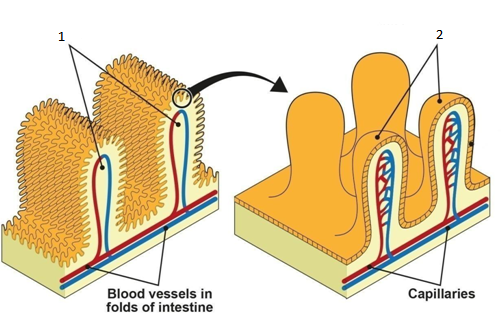7th Grade > Biology
NUTRITION IN ANIMALS MCQs
Total Questions : 115
| Page 5 of 12 pages
:
Labelling - 1 Mark each
Reason for folds: 1 Mark
1 - Villi
2 - Microvilli
Villi exist in the small intestine, and the main function of the small intestine is absorption. Absorption is directly dependent on surface area. So to increase the surface area, the internal surface of the intestinal wall is folded onto itself creating villi.
Again the surface of each villus is convoluted in asimilar fashion and the resulting microscopic structures are called as microvilli (brush border).
:
Structure: 1 Mark
Length of small intestine: 1 Mark
Length of large intestine: 1 Mark
The digestive system begins with the mouth and is followed by the pharynx, the oesophagus, the stomach, and the intestine, which is divided into two major sections: the small intestine and the large intestine.
The small intestine is a long and narrow tube about 6 to 7 metres (20 to 23 feet) long.
The large intestine is wider and shorter than small intestine. It is about 1.5 metre in length.
:
Functions of bile juice: 1 Mark each
1. Bile juiceemulsifiesfats and breaks themdown into small particles. This is a detergent-like action of bile which helps the body to absorb the broken down fat products in the gut. In connection to this, bile salts bind with lipids to form micelles. This is then absorbed through the intestinal mucosa.
2. Bile juicehelps in the absorption of fat-soluble vitamins.
3.Bile also serves as the route of excretion for bilirubin, a by-product formed during thedestruction of red blood cells.
:
Stomach specialty: 1 Mark
Digestion process: 1 Mark
Example: 1 Mark
The stomachof ruminantanimals isspecial because itisfour-chambered.
In their four-chambered stomach, cellulose is broken down by microorganisms in the rumen. A diverse group of microbes lives in the digestive system of ruminants.
A good example of a ruminant animal is the cow.
Question 45. Complete the following table: [5 MARKS]
Digestive juices and enzymesSubstance digestedProduct FormedSalivaAmylaseGastric juiceProtease (pepsin) and hydrochloric acidPancreatic juiceProteases(trypsin)LipasesAmylaseIntestinal enzymesPeptidasesSucraseLactaseMaltaseBile from the liverBile salts
Digestive juices and enzymesSubstance digestedProduct FormedSalivaAmylaseGastric juiceProtease (pepsin) and hydrochloric acidPancreatic juiceProteases(trypsin)LipasesAmylaseIntestinal enzymesPeptidasesSucraseLactaseMaltaseBile from the liverBile salts
:
Rows of the table: 1 Mark each
DigestivejuicesandenzymesSubstancedigestedProductFormedSalivaStarchMaltoseAmylaseGastricjuiceProteinsPeptonesProtease(pepsin)andhydrochloricacidPancreaticjuiceProteases(trypsin)ProteinsPeptides and amino acidsLipasesFats emulsified by bileFatty acids and glycerolAmylaseStarchMaltoseIntestinalenzymesPeptidasesPeptidesAmino acidsSucraseSucrose (sugar)Glucose and fructoseLactaseLactose (milk sugar)Glucose and galactoseMaltaseMaltoseGlucoseBilefromtheliverBilesaltsFat globulesSmaller Fat Globules
:
Similarity: 1 Mark
Difference: 1 Mark
Similarity: The mode of nutrition is holozoic, both in amoeba and human beings.
Difference: In amoeba, digestion is intra-cellular but in human beings digestion is extracellular.
:
Examples: 0.5 Mark each
Cows and goats are examples of ruminant animals.
Answer: Option A. -> True
:
A
∙ Salivary glands, liver and pancreas secrete digestive juices which convert complex substances of food into simpler ones.
∙ For example,salivacontains the enzyme amylase, which is capable of breaking down starch into simpler sugars.
∙ The digestive juices also turns food into smooth porridge called called chyme.
:
A
∙ Salivary glands, liver and pancreas secrete digestive juices which convert complex substances of food into simpler ones.
∙ For example,salivacontains the enzyme amylase, which is capable of breaking down starch into simpler sugars.
∙ The digestive juices also turns food into smooth porridge called called chyme.
Answer: Option B. -> heterotrophic
:
B
The mode of nutrition in human beings ishetrotrophic.An organism that cannot manufacture its own food and instead obtains its food and energy by taking in organic substances, usually plant or animal matter are called heterotrophs. All animals,protozoans, fungi, and most bacteria are hetrotrophs.
:
B
The mode of nutrition in human beings ishetrotrophic.An organism that cannot manufacture its own food and instead obtains its food and energy by taking in organic substances, usually plant or animal matter are called heterotrophs. All animals,protozoans, fungi, and most bacteria are hetrotrophs.
Answer: Option A. -> True
:
A
Digestive juices convert complex substances infood into simpler ones.Salivacontains the enzyme amylasewhich is capable of breaking down starch into simpler sugars such as maltose.
:
A
Digestive juices convert complex substances infood into simpler ones.Salivacontains the enzyme amylasewhich is capable of breaking down starch into simpler sugars such as maltose.

















